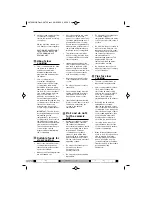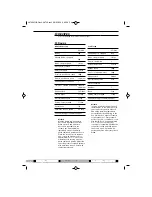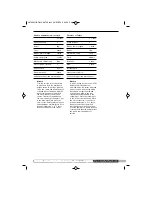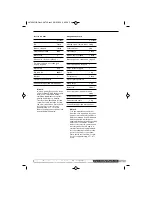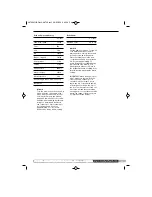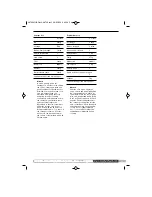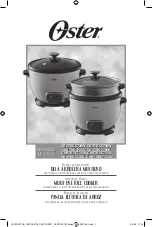
4
UK Helpline 0844 871 0956
Replacement Parts 0844 873 0722
Ireland Helpline 1800 409 119
5
Switch off and unplug the slow
cooker after cooking and
remove the ceramic pot using
oven gloves.
Always place the ceramic pot
on a heat proof mat or surface.
CAUTION: BE CAREFUL NOT
TO TOUCH THE BASE UNIT
AFTER COOKING AS IT
REMAINS HOT.
About slow
cooking
•
Slow cooking has always been
the best way to prepare a
nutritious hot meal with
minimum preparation and
maximum free time away from
the kitchen.
•
Slow cooking gives you
convenient, versatile and
flavoursome food. The longer
cooking times allow better
distribution of flavours, giving
them time to blend and season
the food. A slow cooker heats
food gently, making it a great
way to cook meats - in
particular, less-expensive cuts,
such as stewing beef, which
are tenderised through the long
cooking process
.
Remember,
there are no limits to the
potential uses of your slow
cooker, only your imagination!
IMPORTANT: The slow cooker
works by building up heat and
maintaining an even
temperature. To get the best
cooking results, do not remove
the lid during cooking, since
this will lose heat and therefore
slow down the cooking time.
The see-through lid allows you
to monitor the cooking
progress without interrupting
the cooking time.
Suitable foods for
slow cooking
•
Most foods are suited to slow
cooking methods, however
there are a few guidelines that
need to be followed.
•
Make sure all frozen ingredients
are well thawed out.
•
Cut root vegetables into small,
even pieces, as they take
longer to cook than meat. They
should be gently sauted for 2-3
minutes before slow cooking.
Ensure that root vegetables are
always placed at the bottom of
the pot and all ingredients are
immersed in the cooking liquid.
•
Trim all excess fat from meat
before cooking, since the slow
cooking method does not allow
fat to evaporate.
•
If adapting an existing recipe
from conventional cooking, you
may need to cut down on the
amount of liquid used. Liquid
will not evaporate from the slow
cooker to the same extent as
with conventional cooking.
•
Never leave uncooked food at
room temperature in the slow
cooker.
•
Do not use the slow cooker to
reheat food.
•
Uncooked red beans must be
soaked and boiled for at least
10 minutes to remove toxins
before use in a slow cooker.
•
Insert a meat thermometer into
joints of roasts, hams, or whole
chickens to ensure they are
cooked to the desired
temperature.
Do’s and do not’s
for the ceramic
pot
•
Authentic stoneware is fired at
high temperatures, therefore,
the ceramic pot may have
minor surface blemishes, the lid
may rock slightly due to these
imperfections. Low heat
cooking does not produce
steam, so there will be little
heat loss. Due to normal wear
and tear through the products
life, the outer surface may start
appearing ‘crazed’.
•
Do not put the ceramic pot or
lid in an oven, freezer,
microwave or on a
gas/electrical hob.
•
Do not pre-heat before adding
ingredients.
•
Do not subject the ceramic pot
to sudden changes in
temperature. Adding cold water
to a very hot pot could cause it
to crack.
•
Do not allow the pot to stand in
water for a long time (you can
leave water in the pot to soak).
There is an area on the base of
the ceramic pot that has to
remain unglazed for
manufacturing purposes. This
unglazed area is porous,
therefore will soak up water,
this should be avoided.
•
Do not switch the cooker on
when the ceramic pot is empty
or out of the base.
Tips for slow
cooking
•
The slow cooker must be at
least half full for best results.
•
Slow cooking retains moisture.
If you wish to reduce this,
remove the lid after cooking
and turn the control to high (if
set to low or medium) and
reduce the moisture by
simmering for 30 to 45 minutes.
•
Removing the lid will allow
valuable heat to escape,
reducing the efficiency of your
slow cooker and increasing the
cooking time. If you remove the
lid more than a couple of times
to stir or add ingredients, then
you will need to allow 10-15
minutes extra cooking time
each time you remove the lid.
•
If cooking soups, leave 5 cm
space between the top of the
cook pot and the food surface
to allow for simmering.
•
Many recipes will take several
hours to cook. If you don’t have
time to prepare food in the
morning, prepare it the night
before, storing the food in a
covered container in the fridge.
Transfer the food to the ceramic
pot and add boiling
liquid/stock.
48790 MUK Rev2:48790 rev2 06/05/2009 09:56 Page 4




